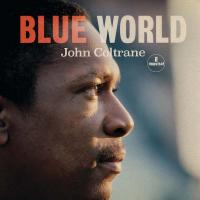My wife is the world's biggest Coltrane fan, so this is going beneath the tree at Christmas!
Impulse!/UMe’s Latest Collection of “Lost” Coltrane Recordings is Surprisingly Great
Upon Le chat dans le sac’s release, little did most people know that soundtracking the film were new Coltrane recordings, not those tracks’ previously released original sessions. During UMe's recent search for unreleased Coltrane material (which also yielded last year's Both Directions At Once), the Le chat dans le sac soundtrack tape became Blue World, released September 27.
I became suspicious earlier this past summer when I saw the Blue World announcement. The release is obviously entirely official, but "lacquers cut by Ron McMaster" stood out. Isn't he retired? Yes. Ron retired from Capitol Mastering last year, showing that Universal planned and cut Both Directions At Once and Blue World (and probably a long string of archival Coltrane releases we don't even know about yet) at the same time. Despite that, I paid the $22 for Blue World, and surprisingly, it's much better than expected.
Both Directions At Once captured Coltrane in 1963, one day before the John Coltrane & Johnny Hartman session. On that release, there are several takes of his current compositions such as "Impressions" as well as two untitled, previously unreleased compositions. In my review, I found it to be a decent enough album, but one that didn’t live up to the hype. Blue World, however, may not be hyped enough. This session finds Coltrane in between Crescent and A Love Supreme; a period where his compositions became increasingly lush, spiritual, and lengthy, with even greater attention to detail. Blue World shows Trane recontextualizing these previously recorded compositions as well as introducing “Blue World,” a contrafact (a new melody on a previously used harmonic structure) of the Harold Arlen standard “Out Of This World.”
On this set, Coltrane’s “Classic Quartet” of himself, pianist McCoy Tyner, bassist Jimmy Garrison, and drummer Elvin Jones is in top form; although not significantly breaking new ground, at every turn they offer fresh innovations on the older material. Whereas Coltrane’s Atlantic sessions, especially in the first half of his tenure there, featured whichever musicians were available, the Classic Quartet had been together for two years prior to the Blue World session. Inevitably, it was a far tighter unit than Trane’s previous groups; they sensed each other’s forthcoming moves and musically pushed each other forward. While that excellent cohesion has always been easily recognized, comparing the Blue World takes (specifically those of “Naima,” one of his most performed, and therefore altered, songs) to the compositions’ original recordings truly highlights its importance in Coltrane’s Impulse!-era sound, specifically his musical boundary-breaking.
The LP, despite being sourced from a mono mix intended for an optical film soundtrack sounds excellent. Cut from the Kevin Reeves-mastered 192/24 file by Ron McMaster, the sound is three-dimensional, clean, and lively. Coltrane’s tenor comes through clearly and fluidly, Jimmy Garrison’s bass is appropriately thick and muscular, Elvin Jones’ drums create a large reverberation through Van Gelder Studios, and while not miked the best, McCoy Tyner’s piano sound gets the job done. What likely explains why even the files of Blue World sound better than those of Both Directions At Once is that the former's source tape runs at 15ips, while the latter’s is at 7.5ips. Further, QRP's standard weight pressing is mostly quiet, though make sure to clean it as the printed paper inner sleeve might embed some dirt into the grooves.
However, the jacket artwork drastically lacks artistic creativity. While the Both Directions At Once cover has a session photo as well as (on the deluxe editions) a die-cut jacket, Blue World's artwork is only a photo of Coltrane with a lame, tacky font for the album title. I understand that since this wasn’t originally an Impulse! session, session photos are probably non-existent (not that Impulse! took that many session pictures anyway), but the font and color choices don't even come close to matching the artistic value of Robert Flynn's classic Impulse! covers. All the Blue World cover looks like is that of the normal, lazy posthumous release, which this otherwise isn’t.
Also messed up is the orange color on the spine. I know that, due to different printing techniques, it can be hard to get accurate colors, but the orange is way off the mark in tone and texture compared to original Impulse! spines. However, the back cover and inner sleeve have decent photo collages of Coltrane as well as some Le chat dans le sac stills, and Ashley Kahn's liner notes are, as always, insightful. Overall, this archival session's release is a win for Ume’s recently revitalized Impulse! sector.
- Log in or register to post comments


Thank you for the shopping link.
I love Music Direct and I hope using the link supports Analog Planet!

Is how I felt when I received and listened to Blue World. Malachi, your review is right on target. Keep up the good work!

Best written review yet. Great detail, makes me want the album (which I'll get eventually). I find it interesting that you seem like a tougher reviewer than your mentor (who's probably soused when he writes his reviews (just kiddin Mike)), I mean you're even criticizing the color of the spine. Keep up the good research and effort. BTW, how did you find out the IPs speeds for those (2) master tapes?



